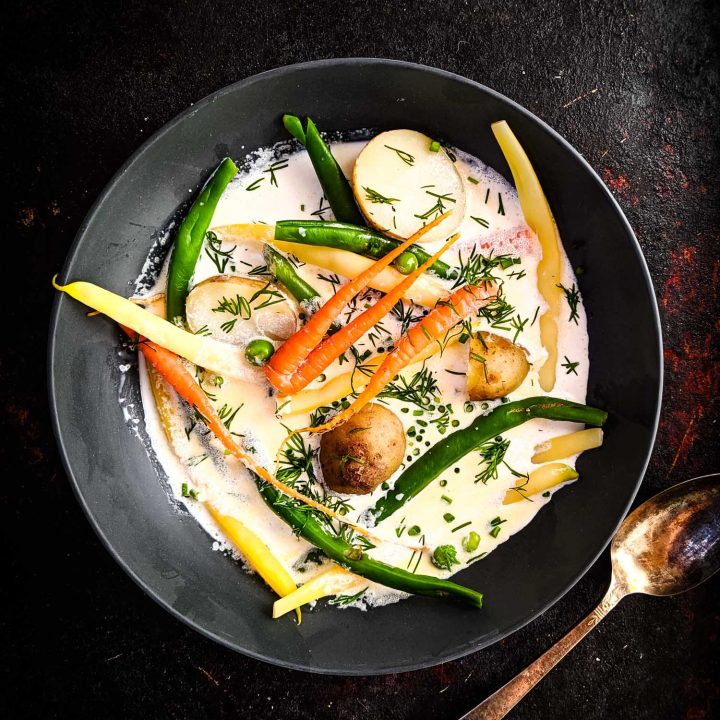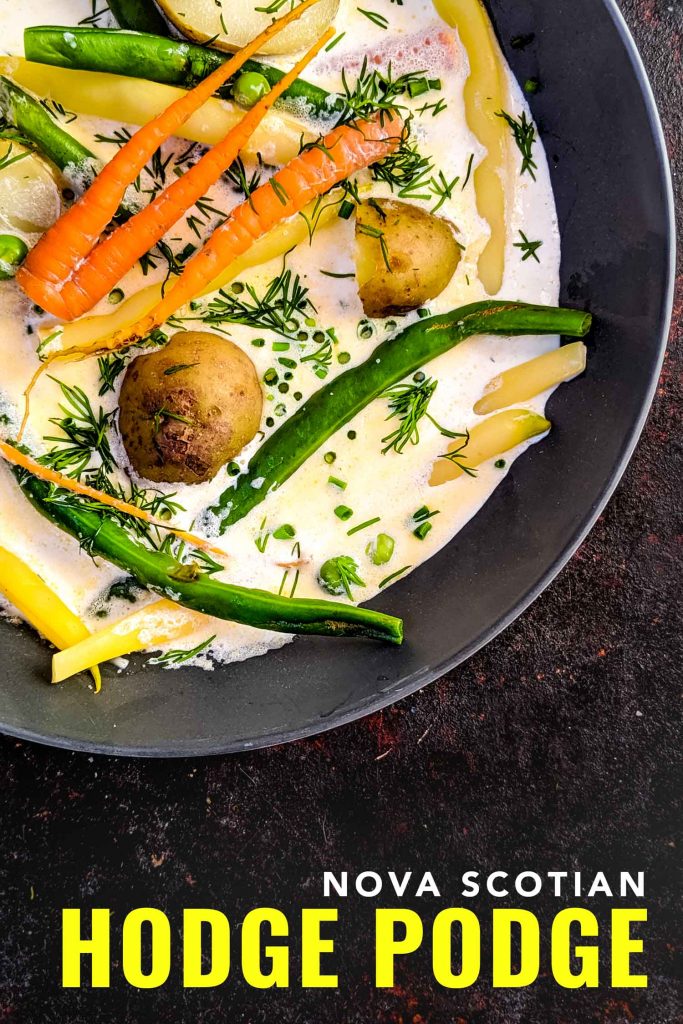Traditional hodge podge is a Nova Scotia classic summer recipe. It’s sometimes called vegetarian chowder as it’s fresh summer vegetables in milk or cream.
It’s a Nova Scotia classic and has ALWAYS been vegetarian because we’re not just a land of amazing seafood.
I grew up in the Annapolis Valley. It was once a booming apple valley, but many of the orchards are now vineyards making incredible Nova Scotia wine.
Yet we’re still an agricultural area in the Valley. I didn’t grow up wearing a souwester and hanging out with fishermen, the backdrop of my childhood was farmland.
Nova Scotia Blueberry Grunt Dessert
We ship apples, blueberries (especially wild blueberries) throughout Canada and all over the world.
And while I didn’t grow up on a farm (thankfully as I’m too lazy for that) I did grow up with the culture of visiting farmer’s markets and stands first.
The best produce isn’t in a grocery store. It is in one of the MANY farmer stands as you drive through the small villages in Nova Scotia.
And this is why I love this hodge podge recipe. Because it celebrates the simplicity of fresh vegetables. I must admit I didn’t even try hodge podge until this year.
Perhaps that’s for the best as I can truly appreciate.
MORE EAST COAST RECIPES:
Mussel Chowder
Lobster Pasta Salad
Nova Scotia Seafood Chowder
Snow Crab Cakes
If I had eaten it while I was young I would have scoffed at the idea of having vegetable chowder when I could be having seafood chowder.
But when I researched the history behind hodge podge I was able to see so many parts of Maritime culture that I don’t notice because it’s just normal life here.
I’m sharing this Nova Scotia hodge podge because it’s not something you can find in restaurants outside the Acadian shore.
It’s something that you buy ingredients for and make at home.

What is Hodge Podge?
You can find “hodge podge” all over the world. It means using whatever ingredients are available to make a soup or stew. In many countries it’s a beef stew, or uses chicken and other meat.
But in Maritime cuisine, Nova Scotia hodge podge is very different.
While it follows the same versatile spirit of adding what you have available, it’s a bit more streamlined. The recipe for hodge podge in Nova Scotia is farm fresh vegetables in butter and cream.
But this is where it gets interesting.
Nova Scotia hodge podge celebrates early summer vegetables. It’s not about waiting for the carrots to grow large or potatoes to be stored.
It uses the OG baby carrots (not the ones manufactured in the store) and new potatoes that are freshly dug and haven’t yet been cured in a storage cellar.
Nova Scotia Hodge Podge History
The word hodge podge originates from Old French. In France there’s an old stew recipe for vegetables and meat called hochepot.
Hocher means to shake in French and it was basically a bunch of ingredients thrown or shaken in a pot.
So it’s most likely that hodge podge came from our Acadian settlers, who farmed the new world land.
They didn’t have the luxury of waiting for the vegetables to mature completely, they needed to eat all season long.
Acadian hodge podge makes most sense that the new settlers adapted this dish to fresh, seasonal vegetables without meat.

What Vegetables are in Hodge Podge?
Fresh young vegetables bathed in cream, the beauty of this simple recipe is that it is extremely versatile.
Farmer’s markets will often have hodge podge mixes and they are basically whatever is seasonal at the time.
However, it’s most common to see new potatoes, green and yellow wax beans, new carrots and peas. But it’s also possible to find turnip (gross), young onions with silver skins, asparagus and garlic scapes.
Most often the vegetables are thoroughly scrubbed and skins are left on.
The vegetables are young so no need for peeling. If you’re not familiar with the term new potato it means small potatoes that were dug 2 months after planted. They are small with thin skins and you never need to peel them.

How to Make Hodge Podge
I’ve included a full recipe below but there are basically two traditional ways to make hodge podge:
1) Boil or steam the vegetables and then add them to cream and butter. You can cook the vegetables separately (potatoes and carrots for 15-20 minutes, beans 7-10 minutes.
I prefer this method because the carrots and potatoes will take longer than beans and peas. You put all the ingredients in a mixture of cream and butter
2) Simmer the vegetables in the cream and butter for up to 45 minutes. This method makes for a richer flavour as the vegetables cook in cream.
But it takes longer as the potatoes take a while to cook so you should add potatoes and carrots before beans, unless you like mushy green beans.
And then there’s MY third way, which is longer but I think better:
The challenge with cooking vegetables together, whether it be sheet pan recipes, kabobs or stews is that some vegetables take longer to cook than others.
You either get undercooked potatoes or overcooked beans.
Plus simmering and boiling is a great way to cook the vegetables in hodge podge. BUT it also makes them less vibrant.
This is a great recipe as an easy main dish for entertaining. But you eat with your eyes, no one wants a greyish green bean.
This recipe combines the control benefit of boiling AND the flavour benefit of simmering.
I blanch each of the vegetables to keep the brilliant colours and to control how long each has been cooked. If you are entertaining guests and don’t want to be cooking the entire time this is a great option.
You can begin by blanching the vegetables and then put into the cream when you are ready to finish the dish.
When guests arrive, simmer the vegetables until they are done. You get control + flavour.
How to Blanch Vegetables:
- Create an ice bath by filling a large bowl with ice and water.
- Bring a pot of heavily salted water to a boil.
- Boil small vegetables (beans, asparagus etc) for 60 seconds, carrots 90 seconds, potatoes 2 minutes
- With slotted spoon remove vegetables and plunge in ice bath, which stops cooking process.

Hodge Podge Wine Pairings
I visited local wineries armed with questions of pairing Nova Scotia wine with typical food in Nova Scotia.
I thought this would be a tough pairing question as there’s a combination of butter and cream with spring green vegetables.
I’ve always been told that green vegetables are tough to pair wine. Yet no one skipped a beat when I asked about pairing with a hodge podge recipe. Here’s are some great options:
- Avondale Sky Canadian Oak L’Acadie Blanc – suggested by Winemaker Ben Swetnam
- Benjamin Bridge Non-Vintage Brut – suggested by Assistant Winemaker Alex Morozov
- Blomidon Estate Winery Chardonnay – suggested by Winemaker Simon Rafuse.
- Domaine de Grand Pre Rosé – suggested by Oenologist Jürg Stutz
- Gaspereau Vineyards – suggested by Winemakes Gina Haverstock
- L’Acadie Vineyards Estate L’Acadie – suggested by Winemaker Bruce Ewart
- Luckett Vineyards L’Acadie – suggested by Assistant Manager Geena Luckett
- Mercator Vineyards Sauvage Sur Lie – suggested by Winemaker Becca Griffin
- Planter’s Ridge L’Acadie – suggested by Wendy
- Chardonnay (Blomidon) or L’Acadie Blanc – suggested by Laila North of Uncork Nova Scotia

My Hodge Podge Recipe
Can I Use Lower Fat Milk or Cream?
Absolutely. But I would personally not go lower than 2% milk. I find when cooking with milk with lower fat percentages the texture starts to become a bit odd.
I’d rather use a higher percent milk and cut it with water or broth. I have no science to explain why, it’s just personal experience. If I had guests over I’d use the 35% cream, but at home use whatever you have available.
Is this Hodge Podge Gluten Free?
Yes, I’ve used corn starch as the thickener for this recipe instead of flour to keep it gluten free.
Can I Add Bacon?
You don’t need to ask twice. I did keep this as a vegetarian recipe. But many Nova Scotia hodge podge recipes use a bit of bacon with the butter to give it flavour.
Some cooks also add in a bit of fish when simmering the vegetables to make a hearty hodgepodge soup recipe.
How Do I Make Vegan Hodge Podge?
Using a non-dairy milk alternative you could make vegan hodge podge as long as the liquid could be heated.
Also avoid sweetened milks like vanilla almond milk – you want something that has no flavour and limited sugar.
Can I Freeze Hodge Podge?
Technically yes as the recipe calls for milk with a higher fat percentage. But the potatoes and vegetables just don’t hold up to rewarming.
If you don’t mind mealy, mushy vegetables you could do it?

Nova Scotia Hodge Podge Recipe
Hodge podge is a Nova Scotia vegetable chowder using fresh summer vegetables bathed in cream and butter.
Ingredients
- 4 cups fresh vegetables (whole green and yellow waxed beans, small carrots, quartered new potatoes, fresh peas etc)
- 2 tbsp unsalted butter
- 3 cups 10% cream
- 1 cup water from blanching pot
- 2 tbsp cornstarch
- 1/4 cup chopped fresh seasonal herbs (chives and dill)
- sea salt and freshly ground black pepper
Instructions
1. Blanch vegetables (see timing in notes below). Boil small vegetables (beans, asparagus etc) for 60 seconds, carrots 90 seconds, potatoes 2 minutes.
2. Heat heavy bottomed pot over medium. Add unsalted butter. When melted add vegetables to warm through.
3. Add cornstarch to water and mix thoroughly.
4. Add cream and water. Bring mixture to a boil. Then turn heat down to low to let simmer 10 minutes or until vegetables are tender.
5. Season with salt and pepper to taste. Add chives and dill and serve warm.
Notes
Vegetables should be 3/4 done with blanching. As no vegetable is the same, think of it as al dente to be finished in simmering process.
I've given approximate times but you may need to check. I always go light on the smaller veggies as I don't mind them firm, and more time on potatoes as they are ok to be overcooked but not undercooked.
How to Blanch Vegetables:
- Create an ice bath by filling a large bowl with ice and water.
- Bring a pot of heavily salted water to a boil.
- Boil small vegetables first, peas 30 seconds, (beans, asparagus etc) for 60 seconds, carrots 3 minutes, potatoes 4 minutes. Peas
- With slotted spoon remove vegetables and plunge in ice bath, which stops cooking process.
- Keep 1 cup of water from pot for later use.
Pin it For Later: Nova Scotia Hodge Podge



Looks like a really healthy recipe…not sure about the taste though. ..but would really like to give it a try.
I bet it tastes delicious. Healthy and new dish style to try. Thanks!
Great recipe!
Thanks for sharing..
Awesome recipe!
Thanks for sharing..
Talk about a walk down memory lane. I haven’t had hodge podge in yeeeeeeeeears, and for some odd reason it had totally fallen out of my mental recipe file. I just dug up the last of the carrots from my vegetable patch a couple of weeks ago after the first big snowfall, so this sounds like the perfect recipe to show them off.
LOVE authentic local recipes like this one! Looks and sounds delicious and definitely something I will make soon! Pinned.
Love your version of the hodge lodge…looks hearty and perfect for winter’s too!
LOVE a hodge podge! We enjoyed our first taste of this dish when we were in Nova Scotia this past summer and now I love that I have your recipe to try!
Yum! What a great way to use odds n ends of vegetables too! Great history and recipe 🙂
I haven’t been to Nova Scotia since I was a teenager, but I have some very fond memories of good home cooking like this! Thanks for sharing this lovely (and versatile) recipe.
I love the simplicity of this dish and how it celebrates the amazing flavours of new garden vegetables. Thanks for sharing.
Wow – this is a really cool dish- so healthy and simple! I may be in land-locked AB but i’m going to try to make it!
Mother made hodgepodge and so did I as an adult, but never with cornstarch. Having tried it with cornstarch this time, I believe my Acadian mother knew best. Add a new onion and leave out the cornstarch would be my suggestion.
Still tastes of home, and always better on the second day.
Hi, I’m just wondering what you mean by keeping the water for later use? What would you suggest?
Thanks!
It would be absolutely delicious as a soup stock!